The Thoughtful Farmer | Designing Barrington Lifestyles
Barrington’s Fernwood Farm
An Era of Equine Excellence and Champion Showmanship from 1954 to 1972
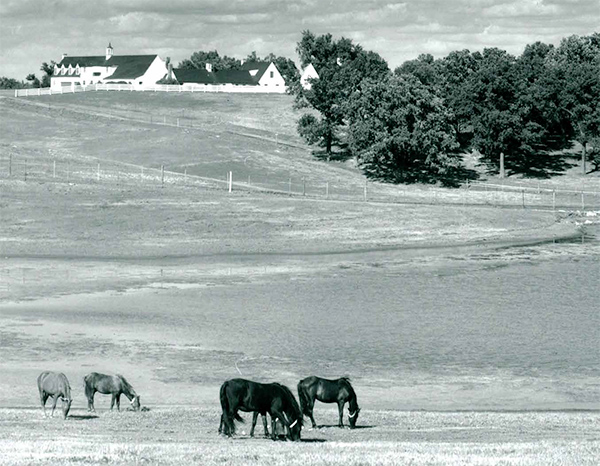
“Fernwood Farm is an eden, a paradise, a verdant oasis for Shetland ponies and the people that loved them.” Too many superlatives? Not if one reads articles and views the photographs from the years that Albert Carl, “Shorty” Buehler presided over the vast acreage in Barrington’s west countryside and created the foremost stables for Shetland ponies to be found anywhere in the United States. Stars of shows which featured six-pony hitches, harness carriage drivers, and individual performers of conformation perfection, the inhabitants of Fernwood Farm were nurtured with a joy that befitted their merry personalities.
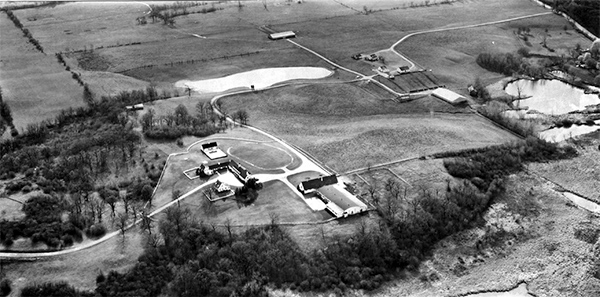
The aerial view of Fernwood Farm shows its proximity to Goose Lake in Barrington Hills, with just a small tip of the lake showing in the lower right corner.
That A.C. Buehler would bring yet another facet to the equine history of the Barrington countryside would happen through a twist of family and business history. His grandfather, Christian Buehler, came from Germany to Philadelphia in the mid-19th century and then to Chicago in the late-19th century. His three sons, led by Carl, grew one of the largest chains of meat and grocery stores in the country. But its bookkeeping was done the old-fashioned way, with a pen, a pad, and quick mental math. This is what in 1918 Carl Buehler apparently told a salesman from central casting with the improbable name of O.E. Cheeseman, who called at the Buehler Bros. Meat Market on Lincoln Avenue.
Cheeseman, according to the history in the Made-in-Chicago Museum, asked Buehler if he was satisfied with the adding machine in his establishment. Buehler, admitting that he didn’t own one, gave Cheeseman his opportunity, and as it turned out, the catalyst for the Buehler family’s future. “Well, sure, the brain can toss around some figures,” chimed Cheeseman, “but my investors and I feel that we have done it one better. I’m talking lickety split addition; huge inventories handled in a few quick strokes. Always accurate! Easy to operate! Lightweight! The brand new Victor Adding Machine is the cat’s pajamas!”
A Life-Changing Calculation
Against his better instincts, but seduced by visions of efficiency, Carl Buehler agreed to a simple transaction. He’d hand over $100 for one of these newfangled magic number processors. It sounded like a bargain; similar machines of the day were selling for nearly twice that price. “Hot dog! It’s a deal,” said Cheeseman.
What Buehler received a few days later, was a certificate for 10 shares of Victor Adding Machine Company stock! Miffed as he was, Buehler decided to see how this dubious “investment” worked out. Before the end of the year, he had plunged into the adding machine business. He went to a Victor stockholders meeting, and saw that everyone involved in the enterprise was intelligent, hardworking, and creative, but he was the only one with proven business experience. The stockholders, recognizing this, voted him president of the fledgling company.
Buehler had a business philosophy, perhaps akin to Marshall Field’s’ “the customer is always right”. His son, A.C., recalled that his father’s basic premise was to try to satisfy the customer, to give good value at a low price. The old idea was to sell a few products at a high price to the top of the economic pyramid. Carl Buehler understood that the further down the pyramid, the bigger the market; that you would sell more if the value was good and the price low.
With that philosophy from his meat market business, Buehler saw no reason it couldn’t carry over to clunky little number crunchers. It did, and by 1921 the business was gaining ground on its competitors with more streamlined models, appealing to a wide spectrum of business owners from the boardroom to the mom-and-pop shop owner.
A.C. Buehler Takes the Reins
In 1921, Carl Buehler named his 24-year-old son Albert Carl “Shorty” Buehler as general manager of the Victor Adding Machine Company. “Shorty” Buehler had originally studied Animal Husbandry and Agriculture at the University of Illinois, but instead of going forward in his father’s meat and grocery business, he grasped the reins of the fledgling company. He would lead Victor for most of the rest of his life and see it become a Fortune 500 company. Bright minds and skilled workers would combine to build one of America’s iconic business success stories. A.C. ran a paternalistic company, with the welfare of his workers always a priority. But he drove himself as well, traveling all over the country to promote new products and support his sales force. Innovation and improvement were the watchwords of Victor.
Exactly when Buehler’s association with Barrington began isn’t clear. That he either leased or owned property in the countryside is suggested by his listing as a member of the Riding Club of Barrington Hills in 1940s directories. Land Records and news articles indicate that A.C. purchased the 360 acres that would become Fernwood Farm in 1954. The acreage was assembled from properties previously owned by Thomas Howell, A.V. Watson, and Orville Caesar. Stretching from Brinker and Otis to Sutton Road and including Goose Lake (named on the earliest surveyors maps of Barrington Township), it was rolling pasture lands, some farmed, and a game preserve probably inherited from Thomas Howell who had held National Retriever Trials there. Initially, Buehler maintained Percherons, Hereford cattle, and Berkshire pigs. But his role in the introduction of the famed Lipizzan horses to America has not been fully understood.
A Patriotic Beginning
A conversation with Shorty’s grandson A.C. Buehler III, confirmed that Shorty had two Lipizzans flown from Austria at the time that General George Patton had assured the survival of the Lipizzans from the occupying Soviet Army. Along with Thoroughbreds and Arabians, six Lipizzans were imported to help rebuild the U.S. Army’s Remount Service. When the Remount Service was disbanded in 1949, these horses went to public auction. Most of the Lipizzans, including an outstanding Hungarian stallion, Pluto XX, were purchased by J.W. Nolan of Garden City, Kansas. When Nolan’s herd was put up for sale in 1954, A.C. Buehler purchased 13 of them, including Pluto XX.
The farm, named for Shorty’s wife Fern, was evolving to what would be described in the coming years as “Fabulous Fernwood”. Shetland ponies were added to the Buehler stables. Nearby in Cary, the Curtiss Farms six-pony hitches of pure black animals were famous as an advertising vehicle for the candy company, appearing in parades and shows all over the country. When they came up for sale, Buehler purchased them. First-class stables were built for the Lipizzans, but trainers and riders were scarce for their highly-specialized performance traditions. Buehler carefully placed them to other owners, and Pluto XX became the progenitor of an outstanding line that stands at Tempel Farms, located in Old Mill Creek, Illinois, to this day.
The Curtiss holdings were disbursed after Otto Schnering’s death, and in 1956, a remarkable young stallion, Curtiss Frisco Pete, became available. Already a two-time National Congress Champion in the highly competitive halter classes, Frisco Pete was like a rock star, drawing crowds in and out of the ring. Seasoned horseman would say that they had never seen a pony like him. His conformation and performance, and his personality, and that he was actually a very gentle creature, endeared him to professionals and public alike.
Frisco Pete Arrives to Fernwood
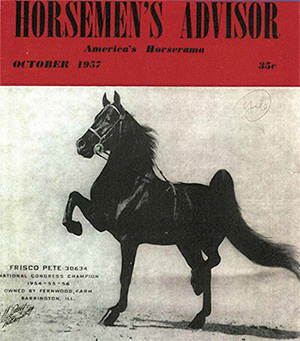
Fernwood’s Frisco Pete graced the cover of Horsemen’s Advisor in 1957. Dudley Abbott, Fernwood’s manager, said, “The only stallion to ever be four-time champion at the National Shetland Congress at Des Moines, Iowa. A winner in hand and harness, this great stallion is fast developing into a top breeding stallion. Frisco Pete and eleven stable mates will tour the major horse shows in 1958.”
With a growing reputation for his Shetland pony stable, A.C. Buehler acquired Frisco Pete, who would win, unequalled to this day, four more National Championships and in a six-year career bring home 150 First Prize Championship ribbons from 154 shows. Frisco Pete gave Fernwood Farm a place in the Shetland history books through his own achievements and his progeny, which excelled in the show ring, harness driving, and as hitch ponies. A visit to Fernwood when Frisco Pete was in residence was the equivalent of a royal audience. A.C.’s granddaughter Pam Varner recalls that his stall was at the end of the stallion barn, with a silver nameplate. When he heard visitors coming he would turn to the back of his stall, walk around to the front, and place himself in his full show pose. He loved company!
The late equine veterinarian David Frederick had one of his first jobs at Fernwood and he remembered walking Frisco Pete from the stallion to the mares’ barn. The pony walked easily at first, and then elegantly transitioned into his natural and perfect trot.
The Famous Six-Pony Hitches
The six-pony hitches added to the Fernwood fame. Renamed for the Victor Adding Machine Company, two teams of hitches, together with the famous replicated miniature fire truck, Sparky the Dalmation, three coachmen, and a driver traveled as extensively as the Curtiss teams had done, and competed in the foremost stock and horse shows. A.C. Buehler’s grandson smiles when he tells about the Victor teams of gleaming ponies often being followed into the ring by the Clydesdales, all to standing room only and cheering crowds.
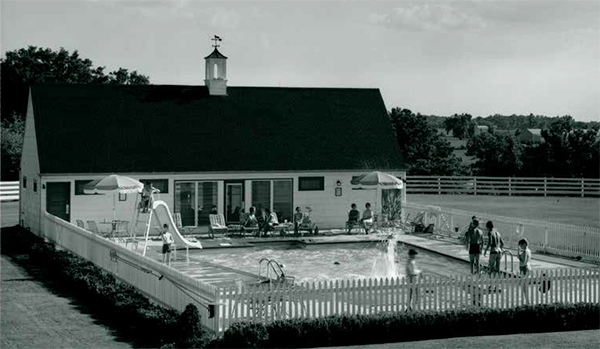
Fernwood Farm’s pool was an attraction for family and guests.
But Fernwood was also a family home, where Shorty and Fern Buehler liked to gather their children and grandchildren giving them everlasting memories. Shorty’s birthday on June 20 was always an important day which would be celebrated with a pool party and visits with all the ponies, many of which could be seen grazing happily in the endless pastures. Buehler, lunch bucket along, as was his habit at Victor, spent at least two days a week overseeing the magnificent Fernwood operations, which equaled in perfection those that had given him such business success.
Their beloved Frisco Pete passed away at Fernwood on April 25, 1971. A.C. Buehler passed away at Chicago Wesley Memorial Hospital on September 2, 1971. The shining times that were Fernwood Farm would pass into history. But the land would have a revival in new and brilliant colors as Horizon Farm, and A.C. Buehler would share the fruits of his successful life to benefit the community, a story told on the back page of this issue.
A Permanent Tie to History
On February 10, 1947, A.C. Buehler, the president of the Victor Adding Machine Company, presented Norden Bombsight #4120 to the Smithsonian Institute. This sight was in service on board the Enola Gay when it dropped the first atomic bomb on Hiroshima. Buehler’s Victor Adding Machine Company was the main producer of the bombsights for a period of time, and this presentation forever linked his company to the Norden Bombsight, the Enola Gay, and to history. The presentation to the Smithsonian was essentially the final step in a long-running advertising campaign designed to sell adding machines, linking the precision of the bombsights to the same precision quality and speed of his adding machines. For the success of that bombsight production job, at which others had failed, the Victor Adding Machine Company was given the Army-Navy “E” Award. This award, also known as the Army-Navy Production Award, was created during World War II to foster the mobilization and production of wartime materials. By the war’s end, only five percent of the 85,000 or more companies involved in the U. S. military effort received this award.
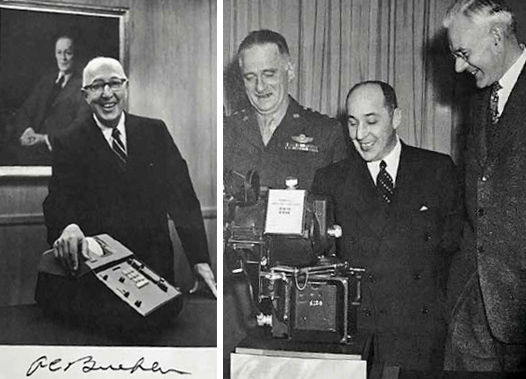
Above left: A.C. Buehler is pictured in front of a portrait of his father, Carl Buehler. Victor Adding Machine Co. was a fledgling company in 1918 when the operator of a successful chain of meat markets of the Buehler family gave a Victor salesman $100 for what he thought was an adding machine. Instead, he got 10 shares of its stock. To protect his investment, Carl Buehler became a director of Victor in September 1918 and was elected president of the company three months later. The first Victor adding machine, Model 110, was introduced in 1919. In 1921, Carl selected his 24-year-old son, A. C., as vice president of operations and advised him to operate the company by “working like the devil, but treat the employees right and allow them to make some money”. Carl also believed in reinvesting most of the profit, so the company could grow. A.C. assumed control of the company after the death of Carl Buehler in 1932.
Above Right: A.C. Buehler (center) presents the Enola Gay’s bombsight #4120 Norden M-9 with X-1 Reflex Sight to the Smithsonian Institute on February 10, 1947. This was the original Norden bombsight used aboard the Enola Gay for the atom bomb drop on Hiroshima in August 1945 during World War II. Pictured with Buehler are General Carl Spaatz, U.S. Air Force (on left) and Rear Admiral William Sterling “Deak” Parsons (on right).
Fabulous Fernwood
“Today, Fernwood Farm is populated with 68 broodmares, 23 hitch ponies and studs at service, including the noble Stormy Weather, and Windy Hills Magic; 24 yearlings, 21 current foals (plus 19 more due this year) and 19 head in training for the shows, including Pete, Mischief and Lucky Silver’s Donna. That’s 155 head, 174 if all foals are safe.
And those foals, both the ones now on the ground and those yet to be dropped, have taken the precaution too of making sure they were born on one of the most magnificent farms imaginable.”
According to the article printed in July 1958, pastures were strong, with Kentucky fescue in a renovation program, and regular pastures were in a timothy-alfalfa-clover mixture. All pastures were under a regular soil improvement program, based on soil tests.
First-Class in Every Way
Buildings were thus described: “Fernwood Lodge, which is a major structure in itself, including a full residence, plus an apartment and four single rooms in one wing for the “Fernwood boys”, extensive offices for Mr. Buehler, an office for Dudley Abbott (his manager-trainer) and one for his secretary; a carriage room, a four-car garage, and a large workshop.
Then there is the main barn arena, measuring 180x34 in the stable wing and 161x50 in the arena; the colt barn; a new foal barn just being built to corner four pastures; a pole barn serving as combination broodmare shelter and machine shed; a small stud barn; the Lipizzan barn now being converted to hold 14 more pony stalls; a hospital and foaling barn; and two residences, one for the groundskeeper and one for Dudley Abbott.”
The article notes that in addition to Goose Lake and two ponds, there is a 5,000-gallon pressure storage tank, and a 50,000 gallon cistern underground that is linked to the fire hydrants.
Early Barrington Riding Traditions
A most important element of the story is about the relationship of Fernwood to the overall equestrian community: “As part of a long-standing community and area agreement Fernwood like her neighbors, is threaded with a winding bridle path which travels many marked miles through the area’s farmlands, with gates that can be opened and closed from horseback. Thus at any given moment a caravan of two to twenty horses may hove into view up a valley, pass through a gate, and go off over a hillside. Every rider is religiously particular about closing the gate behind in return for the privilege.”
The article further says that: “This then, is the site of one of the most up-to-date Shetland nurseries imaginable.”
Fabulous Fernwood indeed!
- - - - - - - -
Barbara L. Benson grew up in Kent, England, and later moved to New York. She settled in Barrington and has walked with our history since she first arrived here in 1980.
